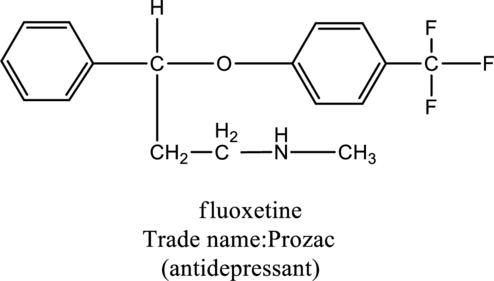
Concept explainers
a.
Interpretation:
For the below compound the chirality centers has to be labeled and number of chiral centers should be determined.

Concept introduction:
Chirality center:
When a carbon atom is bonded to four different groups, then that carbon is named as chiral carbon and it is called as chirality center. Generally, the carbon atom contains tetrahedral valency, therefore it bonded to four atoms or molecules. The chiral center is bonded with four different elements or groups. If the single carbon atom is bonded to two or more identical group or atom, then it is also not considered as chiral carbon. In addition to this, if the carbon atom contains multiple bond then it does not able to bond with four different groups then it is not considered to be as a chirality center.
b.
Interpretation:
For the below compound the chirality centers has to be labeled and number of chiral centers should be determined.

Concept introduction:
Refer to part “a”.
Want to see the full answer?
Check out a sample textbook solution
Chapter 12 Solutions
Principles of General, Organic, Biological Chemistry
- One of the analgesics has a chiral center. Which compound is it? One of the two enantiomers is far more effective at reducing pain than the other.arrow_forwardDigitalis is a preparation made from the dried seeds and leaves of the purple foxglove, Digitalis purpurea, a plant native to southern and central Europe and cultivated in the United States. The preparation is a mixture of several active components, including digitalin. Digitalis is used in medicine to increase the force of myocardial contraction and as a conduction depressant to decrease heart rate (the heart pumps more forcefully but less often).arrow_forwardCodeine can treat pain and cough but has a high risk for addiction and dependence. Which of the following statements about Codeine is false? H3C H- N-CH3 HO O The methoxy group masks an important binding group O The structure is converted to morphine in the brain O The structure is a weaker analgesic than morphine. O The structure acts as a prodrugarrow_forward
- Locate the stereogenic centers in attached drug.arrow_forwardStanozolol is an anabolic steroid that promotes muscle growth. Althoughstanozolol has been used by athletes and body builders, many physicaland psychological problems result from prolonged use and it is bannedin competitive sports. Explain why the pKa of the N—H bond in the pyrazole ring iscomparable to the pKa of the O—H bond, making it considerably moreacidic than amines such as CH3NH2 (pKa = 40).arrow_forwardLook up the structure of lisdexamfetamine (Vyvanse), a drug used in the treatment of attention deficit hyperactivity disorder (ADHD). Redraw it and identify all the functional groups present. What is known about itstherapeutic properties?arrow_forward
- 2) Use compound C (shown below) to answer the following questions. H2N H CH3 compound C H" H3C Br a) Classify compound C as a primary, secondary or tertiary amine. b) Give the IUPAC name for compound C, omitting absolute configuration (R or S) designations. c) In the indicated spaces below, draw the enantiomer, a diastereomer and a Fischer projection of compound C. enantiomer of compound C diastereomer of compound C Fischer projection of compound Carrow_forwardWhy are some chiral drugs are sold as a mixture of enantiomers and why some are not? How enantiomers affect the biological activity of the drugs? Explain.arrow_forwardDraw the structure for a compound with molecular formula C2H2I2F2 a. that is optically inactive because it does not have an asymmetric center. b. that is optically inactive because it is a meso compound. c. that is optically active.arrow_forward
- Saquinavir (trade name Invirase) is a protease inhibitor, used to treat HIV(human immunodeficiency virus). Question : Draw a diastereomer of saquinavir.arrow_forwardThe following compounds are named incorrectly. Draw the structure of each compound and give it a correct name (either IUPAC or common is acceptable.) a) N-phenyl-N-ethyl-2-propanamine b) N-sec-butyl-N-propylmethanamine c) N-methyl-N-ethyl-4-ethylpentanamide d) 2,5-diethylhexanoic acid f Googlo Chegg Course Hero orarrow_forwardBarbiturates with rapid onset and short duration are: O used to treat epilepsy. O not used medically. O used as anesthetics. less addictive.arrow_forward
 Introduction to General, Organic and BiochemistryChemistryISBN:9781285869759Author:Frederick A. Bettelheim, William H. Brown, Mary K. Campbell, Shawn O. Farrell, Omar TorresPublisher:Cengage Learning
Introduction to General, Organic and BiochemistryChemistryISBN:9781285869759Author:Frederick A. Bettelheim, William H. Brown, Mary K. Campbell, Shawn O. Farrell, Omar TorresPublisher:Cengage Learning Macroscale and Microscale Organic ExperimentsChemistryISBN:9781305577190Author:Kenneth L. Williamson, Katherine M. MastersPublisher:Brooks Cole
Macroscale and Microscale Organic ExperimentsChemistryISBN:9781305577190Author:Kenneth L. Williamson, Katherine M. MastersPublisher:Brooks Cole Organic ChemistryChemistryISBN:9781305580350Author:William H. Brown, Brent L. Iverson, Eric Anslyn, Christopher S. FootePublisher:Cengage Learning
Organic ChemistryChemistryISBN:9781305580350Author:William H. Brown, Brent L. Iverson, Eric Anslyn, Christopher S. FootePublisher:Cengage Learning Chemistry for Today: General, Organic, and Bioche...ChemistryISBN:9781305960060Author:Spencer L. Seager, Michael R. Slabaugh, Maren S. HansenPublisher:Cengage Learning
Chemistry for Today: General, Organic, and Bioche...ChemistryISBN:9781305960060Author:Spencer L. Seager, Michael R. Slabaugh, Maren S. HansenPublisher:Cengage Learning



